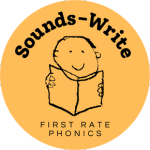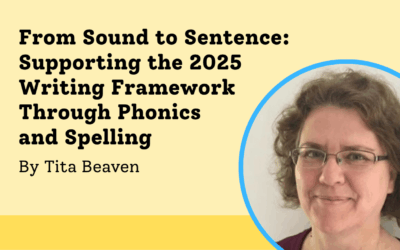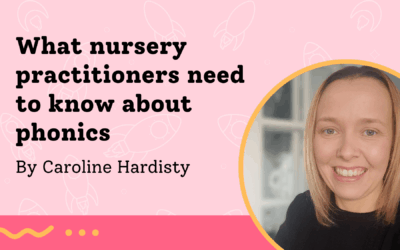Recently, a teacher asked us this question:
“The new statutory framework for writing says children should not be taught writing on a whiteboard or on the carpet, but should be sitting at a table. A number of Sounds-Write lessons involve children writing words and even short sentences on a whiteboard on the carpet. Does this clash with the new requirements?”
This is a really important question—and one that many teachers have raised since the new Writing Framework was published. Let’s unpack what the guidance actually says and how it relates to Sounds-Write practice.
Handwriting and phonics: two distinct strands
The Writing Framework makes a clear distinction between:
- Teaching handwriting: Children need explicit teaching of letter formation, posture, grip, and control. This is best practised at a table, using pencil and paper, with teachers modelling the process step by step.
- Teaching phonics (reading and spelling): Here, children are learning to connect sounds with spellings, segmenting and blending to read and write words. Writing during phonics is not about perfect letter formation—it’s about embedding knowledge of the alphabetic code.
This distinction is crucial. Sounds-Write has always emphasised that handwriting and phonics should be taught in separate sessions
Why Sounds-Write uses mini-whiteboards
So, why do we ask children to use whiteboards in phonics?
- Integration of reading and spelling: Children say each sound as they write each letter, strengthening the link between hearing, saying, seeing, and writing.
- Immediate feedback: When children ‘chin’ their boards, teachers can instantly see their thinking, spot misconceptions, and provide corrective feedback—something far harder to achieve if they’re writing in books at desks.
- Accessible for beginners: Many children actually find whiteboard pens easier to control than pencils in the early stages. The low-stakes nature of whiteboards encourages confidence and risk-taking.
- Taking risks: Many children are more willing to try things out on a mini-whiteboard because errors are easy to correct, and because it’s not a permanent medium like writing in an exercise book.
- Practicality: Writing on whiteboards during short phonics activities leaves teachers free to focus on sound–spelling connections, while dedicated handwriting sessions can focus on posture and letter formation.
As John Walker has written, “writing on whiteboards enables children to start writing in the same instant they start learning to read.” This integration is central to the Sounds-Write approach.
What the Writing Framework really says
The Framework advises schools to choose writing implements and surfaces suited to the purpose of the activity. It stresses the importance of:
- Explicit handwriting teaching (at tables, with pencil and paper).
- Opportunities for physical development alongside writing.
- Separating handwriting instruction from the writing children do in phonics lessons.
This is exactly what we recommend. Whiteboards are not a substitute for handwriting teaching—but they are an excellent tool for phonics.
Could we just move phonics writing to tables?
Yes, it’s possible, and indeed we recommend it when students are a bit older, sometime during Y1. But doing so in Reception risks losing the flexibility, immediacy, and formative assessment that come from carpet-based whiteboard work. It may also reduce children’s engagement. Programmes such as Kinetic Letters even show how writing on the floor can be a powerful developmental strategy.
What matters is clarity of purpose:
- Handwriting → tables, pencils, posture, motor control.
- Phonics → whiteboards (or paper, from Y1 onwards), integrating reading and spelling.
The bottom line
There is no clash between the new Writing Framework and Sounds-Write. Both stress the importance of separating handwriting and phonics while ensuring each gets explicit, purposeful teaching.
So, keep using mini-whiteboards in your Sounds-Write phonics lessons—confident that this practice supports children’s reading and spelling development—while also running regular, explicit handwriting sessions at tables with pencils and paper.
Reflection questions
1. Clarity of purpose
In our school, do we make a clear distinction between phonics writing (to secure sound–spelling links) and handwriting instruction (to develop letter formation and motor skills)?
2. Use of writing surfaces
How do we currently use whiteboards, paper, and pencils in different parts of the curriculum? Are we intentional about matching the tool to the purpose?
3. Feedback and assessment
Do our current classroom routines allow for immediate feedback on children’s phonics writing, and how might whiteboards or alternative approaches support this?
4. Balance and progression
Are children getting enough dedicated handwriting practice at tables with pencils and paper, alongside daily opportunities to practise writing within phonics lessons?
5. Professional confidence
How confident are our staff in explaining to parents, colleagues, or inspectors why we use mini-whiteboards in phonics and how this aligns with the Writing Framework and with our phonics programme?
You may also like
From Sound to Sentence: Supporting the 2025 Writing Framework Through Phonics and Spelling
The newly-published Writing Framework (2025) and the Reading Framework (2023) together offer schools a clear, research-informed direction: secure the foundations of reading and writing early, and build on them progressively throughout primary education. They emphasise...
What Nursery Practitioners Need to Know About Phonics
In nursery settings, practitioners do much more than help children socialise and play—they lay the crucial foundations for their future reading success. One of the most important things early years educators should understand is how spoken language connects to written...
The Phonics Screening Check 2025 (England): Our Analysis
In this post, Sounds-Write's Founder and CEO John Walker examines the structure of the Phonics Screening Check 2025, highlights patterns and potential points of confusion, and offers guidance on how teachers can use this insight to better support early readers. You...




